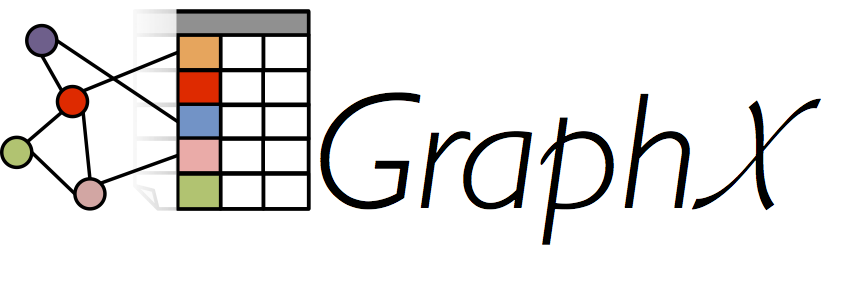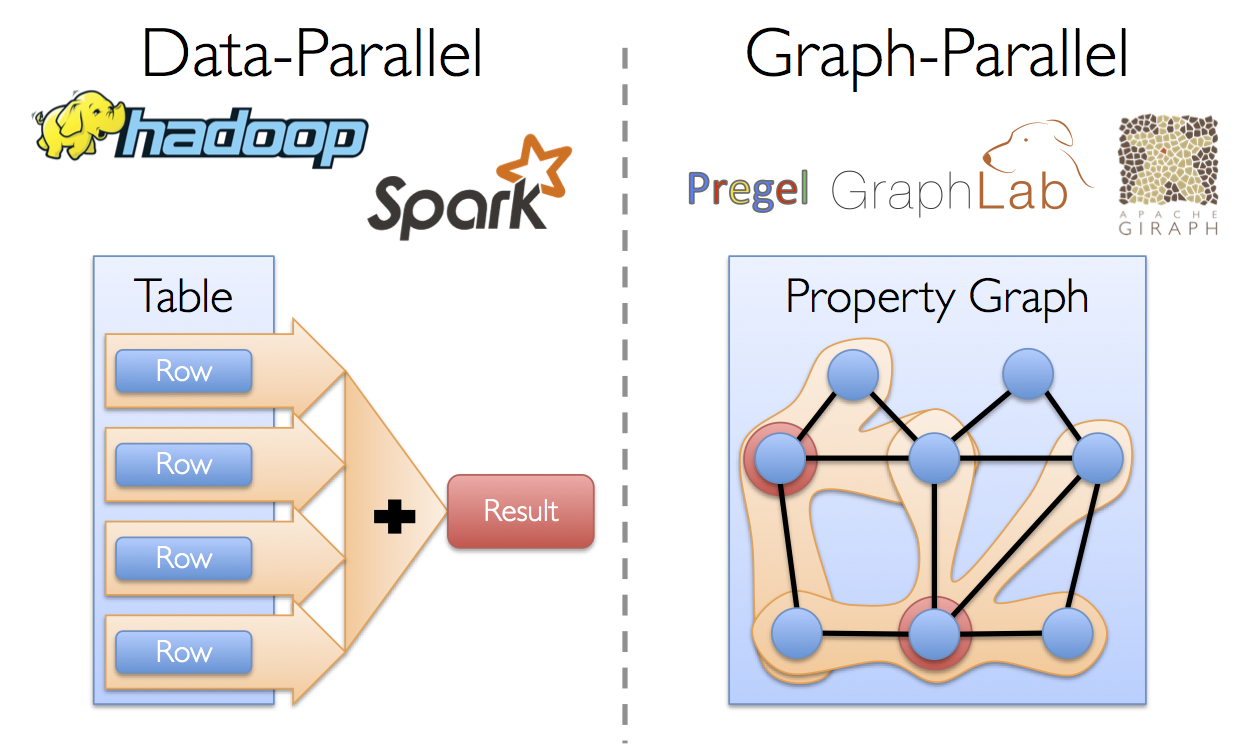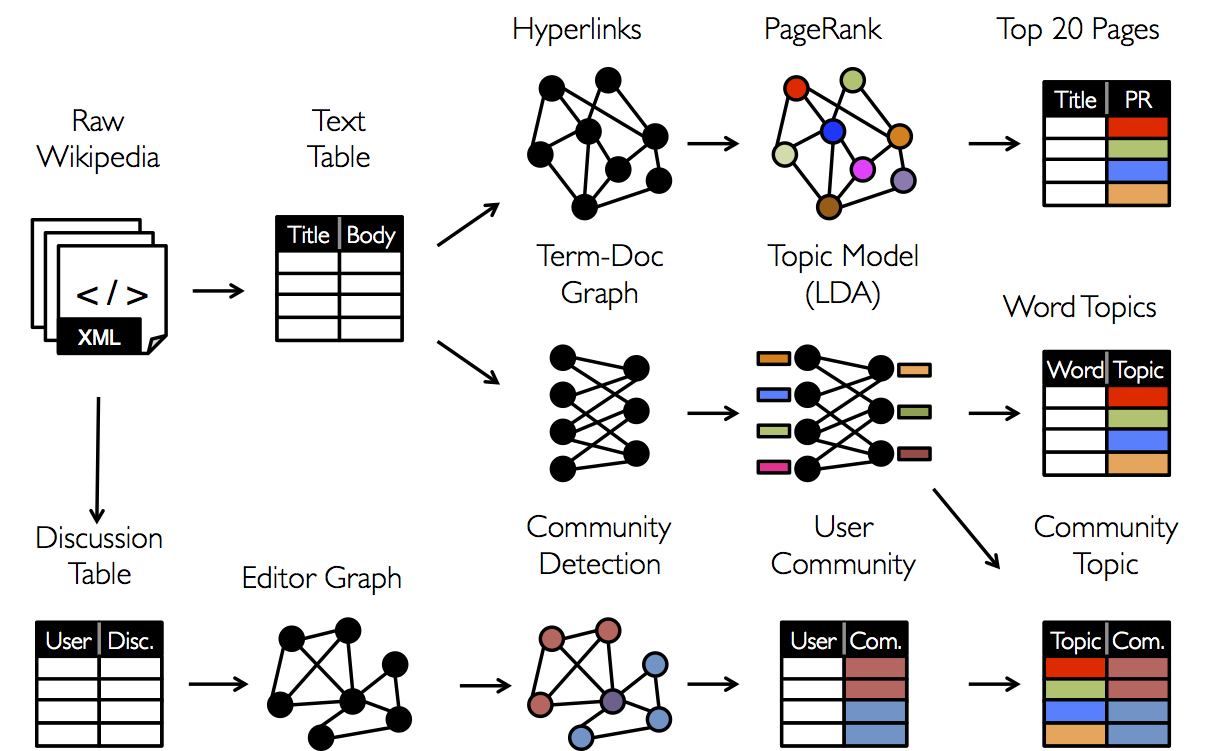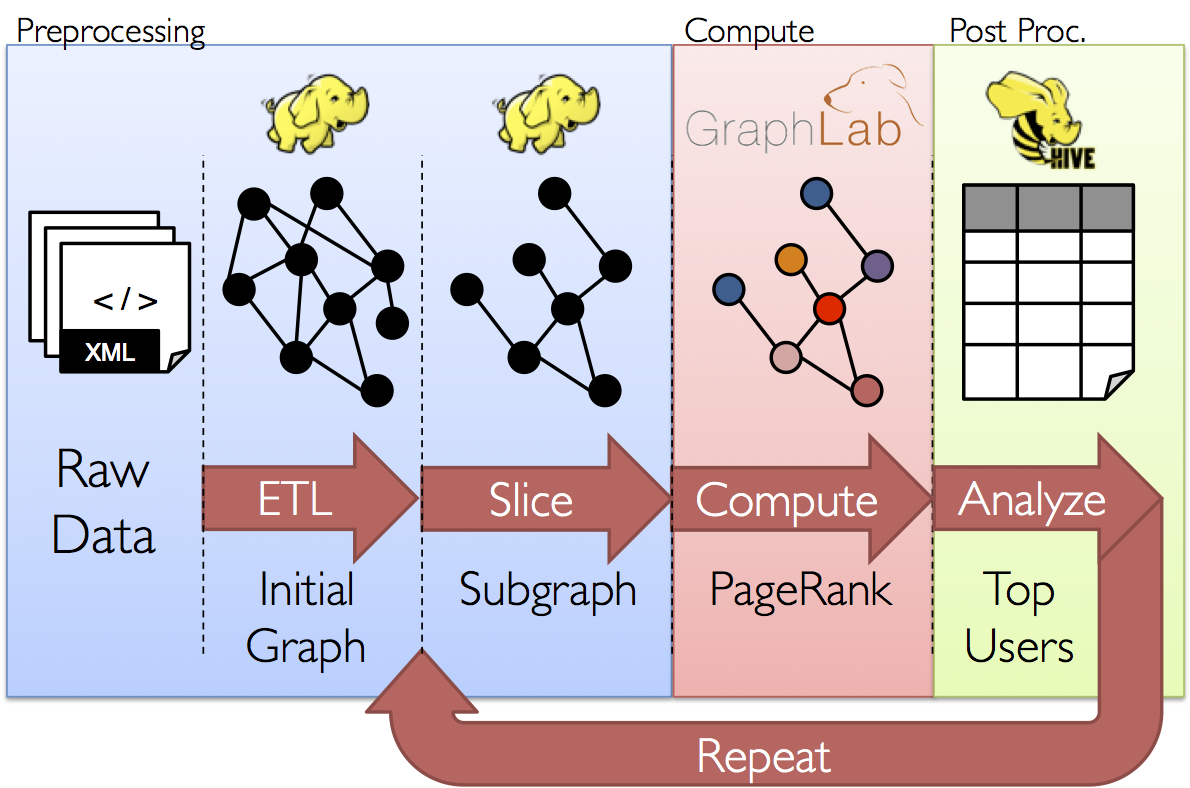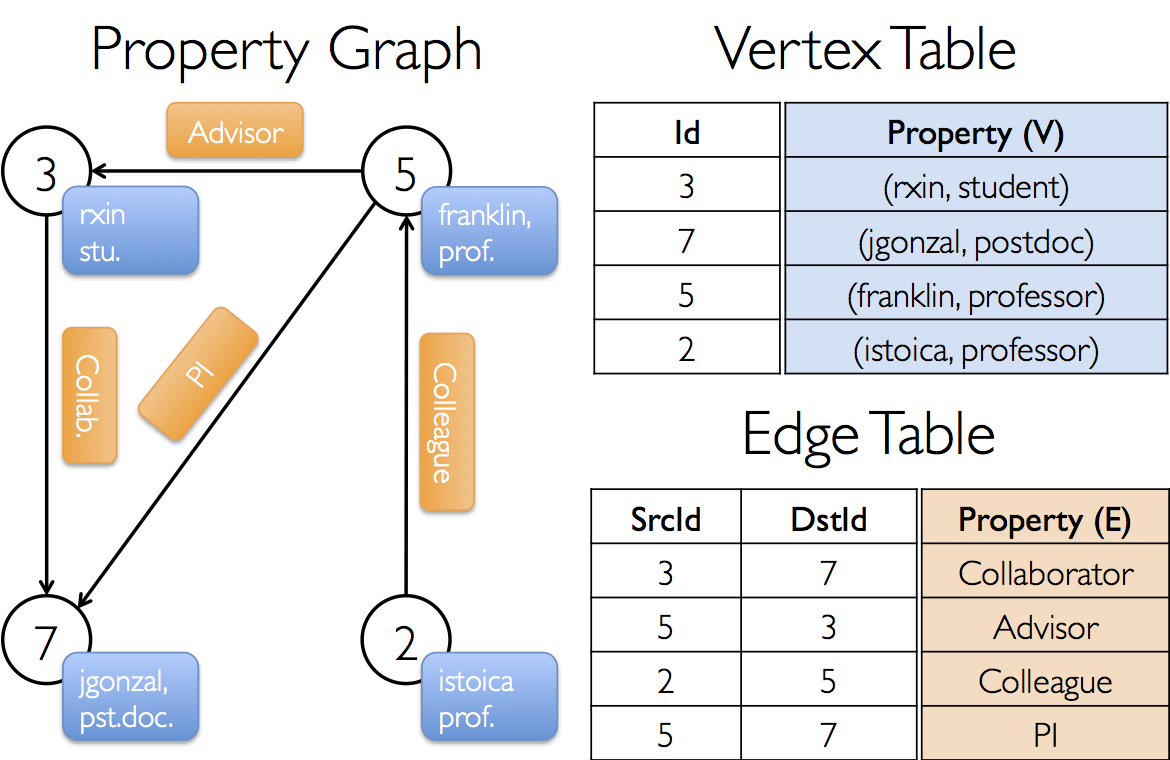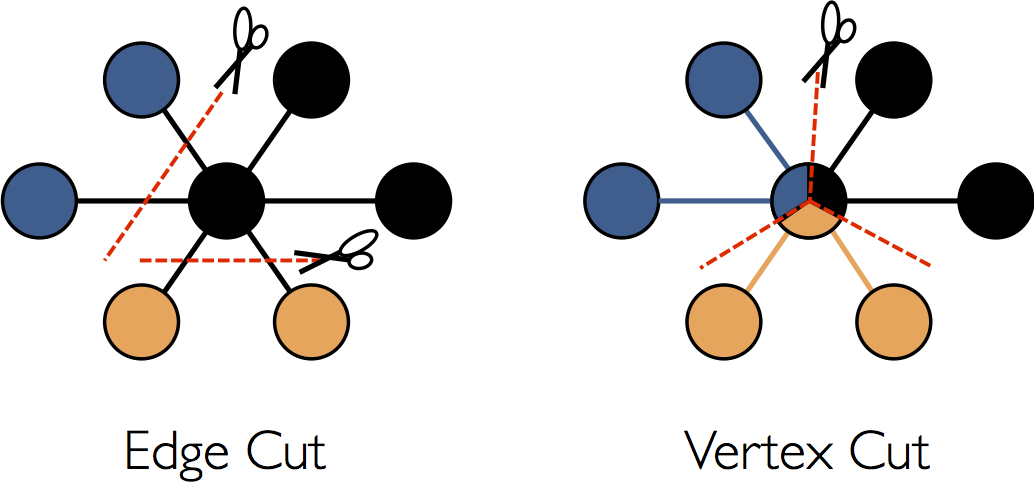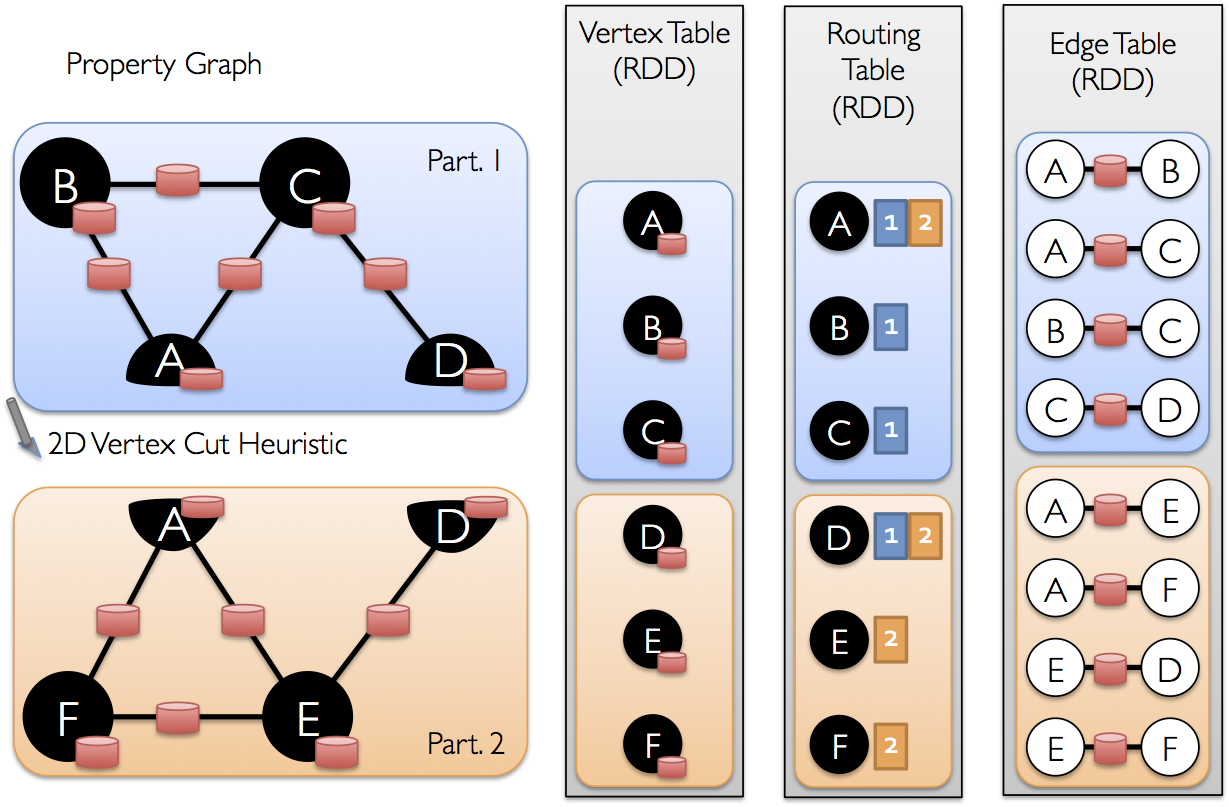| layout | title |
|---|---|
global |
GraphX Programming Guide |
- This will become a table of contents (this text will be scraped). {:toc}
GraphX is the new (alpha) Spark API for graphs and graph-parallel computation. At a high-level, GraphX extends the Spark RDD by introducing the Resilient Distributed Property Graph: a directed multigraph with properties attached to each vertex and edge. To support graph computation, GraphX exposes a set of fundamental operators (e.g., subgraph, joinVertices, and mapReduceTriplets) as well as an optimized variant of the Pregel API. In addition, GraphX includes a growing collection of graph algorithms and builders to simplify graph analytics tasks.
From social networks to language modeling, the growing scale and importance of graph data has driven the development of numerous new graph-parallel systems (e.g., Giraph and GraphLab). By restricting the types of computation that can be expressed and introducing new techniques to partition and distribute graphs, these systems can efficiently execute sophisticated graph algorithms orders of magnitude faster than more general data-parallel systems.
However, the same restrictions that enable these substantial performance gains also make it difficult to express many of the important stages in a typical graph-analytics pipeline: constructing the graph, modifying its structure, or expressing computation that spans multiple graphs. Furthermore, how we look at data depends on our objectives and the same raw data may have many different table and graph views.
As a consequence, it is often necessary to be able to move between table and graph views of the same physical data and to leverage the properties of each view to easily and efficiently express computation. However, existing graph analytics pipelines must compose graph-parallel and data- parallel systems, leading to extensive data movement and duplication and a complicated programming model.
The goal of the GraphX project is to unify graph-parallel and data-parallel computation in one system with a single composable API. The GraphX API enables users to view data both as a graph and as collections (i.e., RDDs) without data movement or duplication. By incorporating recent advances in graph-parallel systems, GraphX is able to optimize the execution of graph operations.
Prior to the release of GraphX, graph computation in Spark was expressed using Bagel, an implementation of Pregel. GraphX improves upon Bagel by exposing a richer property graph API, a more streamlined version of the Pregel abstraction, and system optimizations to improve performance and reduce memory overhead. While we plan to eventually deprecate Bagel, we will continue to support the Bagel API and Bagel programming guide. However, we encourage Bagel users to explore the new GraphX API and comment on issues that may complicate the transition from Bagel.
GraphX in Spark {{site.SPARK_VERSION}} contains one user-facing interface change from Spark 0.9.1. EdgeRDD may now store adjacent vertex attributes to construct the triplets, so it has gained a type parameter. The edges of a graph of type Graph[VD, ED] are of type EdgeRDD[ED, VD] rather than EdgeRDD[ED].
To get started you first need to import Spark and GraphX into your project, as follows:
{% highlight scala %} import org.apache.spark._ import org.apache.spark.graphx._ // To make some of the examples work we will also need RDD import org.apache.spark.rdd.RDD {% endhighlight %}
If you are not using the Spark shell you will also need a SparkContext. To learn more about
getting started with Spark refer to the Spark Quick Start Guide.
The property graph is a directed multigraph
with user defined objects attached to each vertex and edge. A directed multigraph is a directed
graph with potentially multiple parallel edges sharing the same source and destination vertex. The
ability to support parallel edges simplifies modeling scenarios where there can be multiple
relationships (e.g., co-worker and friend) between the same vertices. Each vertex is keyed by a
unique 64-bit long identifier (VertexID). GraphX does not impose any ordering constraints on
the vertex identifiers. Similarly, edges have corresponding source and destination vertex
identifiers.
The property graph is parameterized over the vertex (VD) and edge (ED) types. These
are the types of the objects associated with each vertex and edge respectively.
GraphX optimizes the representation of vertex and edge types when they are plain old data-types (e.g., int, double, etc...) reducing the in memory footprint by storing them in specialized arrays.
In some cases it may be desirable to have vertices with different property types in the same graph. This can be accomplished through inheritance. For example to model users and products as a bipartite graph we might do the following:
{% highlight scala %} class VertexProperty() case class UserProperty(val name: String) extends VertexProperty case class ProductProperty(val name: String, val price: Double) extends VertexProperty // The graph might then have the type: var graph: Graph[VertexProperty, String] = null {% endhighlight %}
Like RDDs, property graphs are immutable, distributed, and fault-tolerant. Changes to the values or structure of the graph are accomplished by producing a new graph with the desired changes. Note that substantial parts of the original graph (i.e., unaffected structure, attributes, and indicies) are reused in the new graph reducing the cost of this inherently functional data-structure. The graph is partitioned across the executors using a range of vertex-partitioning heuristics. As with RDDs, each partition of the graph can be recreated on a different machine in the event of a failure.
Logically the property graph corresponds to a pair of typed collections (RDDs) encoding the properties for each vertex and edge. As a consequence, the graph class contains members to access the vertices and edges of the graph:
{% highlight scala %} class Graph[VD, ED] { val vertices: VertexRDD[VD] val edges: EdgeRDD[ED, VD] } {% endhighlight %}
The classes VertexRDD[VD] and EdgeRDD[ED, VD] extend and are optimized versions of RDD[(VertexID, VD)] and RDD[Edge[ED]] respectively. Both VertexRDD[VD] and EdgeRDD[ED, VD] provide additional
functionality built around graph computation and leverage internal optimizations. We discuss the
VertexRDD and EdgeRDD API in greater detail in the section on vertex and edge
RDDs but for now they can be thought of as simply RDDs of the form:
RDD[(VertexID, VD)] and RDD[Edge[ED]].
Suppose we want to construct a property graph consisting of the various collaborators on the GraphX project. The vertex property might contain the username and occupation. We could annotate edges with a string describing the relationships between collaborators:
The resulting graph would have the type signature:
{% highlight scala %} val userGraph: Graph[(String, String), String] {% endhighlight %}
There are numerous ways to construct a property graph from raw files, RDDs, and even synthetic generators and these are discussed in more detail in the section on graph builders. Probably the most general method is to use the Graph object. For example the following code constructs a graph from a collection of RDDs:
{% highlight scala %} // Assume the SparkContext has already been constructed val sc: SparkContext // Create an RDD for the vertices val users: RDD[(VertexId, (String, String))] = sc.parallelize(Array((3L, ("rxin", "student")), (7L, ("jgonzal", "postdoc")), (5L, ("franklin", "prof")), (2L, ("istoica", "prof")))) // Create an RDD for edges val relationships: RDD[Edge[String]] = sc.parallelize(Array(Edge(3L, 7L, "collab"), Edge(5L, 3L, "advisor"), Edge(2L, 5L, "colleague"), Edge(5L, 7L, "pi"))) // Define a default user in case there are relationship with missing user val defaultUser = ("John Doe", "Missing") // Build the initial Graph val graph = Graph(users, relationships, defaultUser) {% endhighlight %}
In the above example we make use of the Edge case class. Edges have a srcId and a
dstId corresponding to the source and destination vertex identifiers. In addition, the Edge
class has an attr member which stores the edge property.
We can deconstruct a graph into the respective vertex and edge views by using the graph.vertices
and graph.edges members respectively.
{% highlight scala %} val graph: Graph[(String, String), String] // Constructed from above // Count all users which are postdocs graph.vertices.filter { case (id, (name, pos)) => pos == "postdoc" }.count // Count all the edges where src > dst graph.edges.filter(e => e.srcId > e.dstId).count {% endhighlight %}
Note that
graph.verticesreturns anVertexRDD[(String, String)]which extendsRDD[(VertexID, (String, String))]and so we use the scalacaseexpression to deconstruct the tuple. On the other hand,graph.edgesreturns anEdgeRDDcontainingEdge[String]objects. We could have also used the case class type constructor as in the following: {% highlight scala %} graph.edges.filter { case Edge(src, dst, prop) => src > dst }.count {% endhighlight %}
In addition to the vertex and edge views of the property graph, GraphX also exposes a triplet view.
The triplet view logically joins the vertex and edge properties yielding an
RDD[EdgeTriplet[VD, ED]] containing instances of the EdgeTriplet class. This
join can be expressed in the following SQL expression:
{% highlight sql %} SELECT src.id, dst.id, src.attr, e.attr, dst.attr FROM edges AS e LEFT JOIN vertices AS src, vertices AS dst ON e.srcId = src.Id AND e.dstId = dst.Id {% endhighlight %}
or graphically as:
The EdgeTriplet class extends the Edge class by adding the srcAttr and
dstAttr members which contain the source and destination properties respectively. We can use the
triplet view of a graph to render a collection of strings describing relationships between users.
{% highlight scala %} val graph: Graph[(String, String), String] // Constructed from above // Use the triplets view to create an RDD of facts. val facts: RDD[String] = graph.triplets.map(triplet => triplet.srcAttr._1 + " is the " + triplet.attr + " of " + triplet.dstAttr.1) facts.collect.foreach(println()) {% endhighlight %}
Just as RDDs have basic operations like map, filter, and reduceByKey, property graphs also
have a collection of basic operators that take user defined functions and produce new graphs with
transformed properties and structure. The core operators that have optimized implementations are
defined in Graph and convenient operators that are expressed as a compositions of the
core operators are defined in GraphOps. However, thanks to Scala implicits the
operators in GraphOps are automatically available as members of Graph. For example, we can
compute the in-degree of each vertex (defined in GraphOps) by the following:
{% highlight scala %} val graph: Graph[(String, String), String] // Use the implicit GraphOps.inDegrees operator val inDegrees: VertexRDD[Int] = graph.inDegrees {% endhighlight %}
The reason for differentiating between core graph operations and GraphOps is to be
able to support different graph representations in the future. Each graph representation must
provide implementations of the core operations and reuse many of the useful operations defined in
GraphOps.
The following is a quick summary of the functionality defined in both Graph and
GraphOps but presented as members of Graph for simplicity. Note that some function
signatures have been simplified (e.g., default arguments and type constraints removed) and some more
advanced functionality has been removed so please consult the API docs for the official list of
operations.
{% highlight scala %} /** Summary of the functionality in the property graph */ class Graph[VD, ED] { // Information about the Graph =================================================================== val numEdges: Long val numVertices: Long val inDegrees: VertexRDD[Int] val outDegrees: VertexRDD[Int] val degrees: VertexRDD[Int] // Views of the graph as collections ============================================================= val vertices: VertexRDD[VD] val edges: EdgeRDD[ED, VD] val triplets: RDD[EdgeTriplet[VD, ED]] // Functions for caching graphs ================================================================== def persist(newLevel: StorageLevel = StorageLevel.MEMORY_ONLY): Graph[VD, ED] def cache(): Graph[VD, ED] def unpersistVertices(blocking: Boolean = true): Graph[VD, ED] // Change the partitioning heuristic ============================================================ def partitionBy(partitionStrategy: PartitionStrategy): Graph[VD, ED] // Transform vertex and edge attributes ========================================================== def mapVertices[VD2](map: (VertexID, VD) => VD2): Graph[VD2, ED] def mapEdges[ED2](map: Edge[ED] => ED2): Graph[VD, ED2] def mapEdges[ED2](map: (PartitionID, Iterator[Edge[ED]]) => Iterator[ED2]): Graph[VD, ED2] def mapTriplets[ED2](map: EdgeTriplet[VD, ED] => ED2): Graph[VD, ED2] def mapTriplets[ED2](map: (PartitionID, Iterator[EdgeTriplet[VD, ED]]) => Iterator[ED2]) : Graph[VD, ED2] // Modify the graph structure ==================================================================== def reverse: Graph[VD, ED] def subgraph( epred: EdgeTriplet[VD,ED] => Boolean = (x => true), vpred: (VertexID, VD) => Boolean = ((v, d) => true)) : Graph[VD, ED] def mask[VD2, ED2](other: Graph[VD2, ED2]): Graph[VD, ED] def groupEdges(merge: (ED, ED) => ED): Graph[VD, ED] // Join RDDs with the graph ====================================================================== def joinVertices[U](table: RDD[(VertexID, U)])(mapFunc: (VertexID, VD, U) => VD): Graph[VD, ED] def outerJoinVertices[U, VD2](other: RDD[(VertexID, U)]) (mapFunc: (VertexID, VD, Option[U]) => VD2) : Graph[VD2, ED] // Aggregate information about adjacent triplets ================================================= def collectNeighborIds(edgeDirection: EdgeDirection): VertexRDD[Array[VertexID]] def collectNeighbors(edgeDirection: EdgeDirection): VertexRDD[Array[(VertexID, VD)]] def mapReduceTriplets[A: ClassTag]( mapFunc: EdgeTriplet[VD, ED] => Iterator[(VertexID, A)], reduceFunc: (A, A) => A, activeSetOpt: Option[(VertexRDD[_], EdgeDirection)] = None) : VertexRDD[A] // Iterative graph-parallel computation ========================================================== def pregel[A](initialMsg: A, maxIterations: Int, activeDirection: EdgeDirection)( vprog: (VertexID, VD, A) => VD, sendMsg: EdgeTriplet[VD, ED] => Iterator[(VertexID,A)], mergeMsg: (A, A) => A) : Graph[VD, ED] // Basic graph algorithms ======================================================================== def pageRank(tol: Double, resetProb: Double = 0.15): Graph[Double, Double] def connectedComponents(): Graph[VertexID, ED] def triangleCount(): Graph[Int, ED] def stronglyConnectedComponents(numIter: Int): Graph[VertexID, ED] } {% endhighlight %}
In direct analogy to the RDD map operator, the property
graph contains the following:
{% highlight scala %} class Graph[VD, ED] { def mapVertices[VD2](map: (VertexId, VD) => VD2): Graph[VD2, ED] def mapEdges[ED2](map: Edge[ED] => ED2): Graph[VD, ED2] def mapTriplets[ED2](map: EdgeTriplet[VD, ED] => ED2): Graph[VD, ED2] } {% endhighlight %}
Each of these operators yields a new graph with the vertex or edge properties modified by the user
defined map function.
Note that in all cases the graph structure is unaffected. This is a key feature of these operators which allows the resulting graph to reuse the structural indices of the original graph. The following snippets are logically equivalent, but the first one does not preserve the structural indices and would not benefit from the GraphX system optimizations: {% highlight scala %} val newVertices = graph.vertices.map { case (id, attr) => (id, mapUdf(id, attr)) } val newGraph = Graph(newVertices, graph.edges) {% endhighlight %} Instead, use
mapVerticesto preserve the indices: {% highlight scala %} val newGraph = graph.mapVertices((id, attr) => mapUdf(id, attr)) {% endhighlight %}
These operators are often used to initialize the graph for a particular computation or project away unnecessary properties. For example, given a graph with the out-degrees as the vertex properties (we describe how to construct such a graph later), we initialize it for PageRank:
{% highlight scala %} // Given a graph where the vertex property is the out-degree val inputGraph: Graph[Int, String] = graph.outerJoinVertices(graph.outDegrees)((vid, _, degOpt) => degOpt.getOrElse(0)) // Construct a graph where each edge contains the weight // and each vertex is the initial PageRank val outputGraph: Graph[Double, Double] = inputGraph.mapTriplets(triplet => 1.0 / triplet.srcAttr).mapVertices((id, _) => 1.0) {% endhighlight %}
Currently GraphX supports only a simple set of commonly used structural operators and we expect to add more in the future. The following is a list of the basic structural operators.
{% highlight scala %} class Graph[VD, ED] { def reverse: Graph[VD, ED] def subgraph(epred: EdgeTriplet[VD,ED] => Boolean, vpred: (VertexId, VD) => Boolean): Graph[VD, ED] def mask[VD2, ED2](other: Graph[VD2, ED2]): Graph[VD, ED] def groupEdges(merge: (ED, ED) => ED): Graph[VD,ED] } {% endhighlight %}
The reverse operator returns a new graph with all the edge directions reversed.
This can be useful when, for example, trying to compute the inverse PageRank. Because the reverse
operation does not modify vertex or edge properties or change the number of edges, it can be
implemented efficiently without data-movement or duplication.
The subgraph operator takes vertex and edge predicates and returns the graph
containing only the vertices that satisfy the vertex predicate (evaluate to true) and edges that
satisfy the edge predicate and connect vertices that satisfy the vertex predicate. The subgraph
operator can be used in number of situations to restrict the graph to the vertices and edges of
interest or eliminate broken links. For example in the following code we remove broken links:
{% highlight scala %} // Create an RDD for the vertices val users: RDD[(VertexId, (String, String))] = sc.parallelize(Array((3L, ("rxin", "student")), (7L, ("jgonzal", "postdoc")), (5L, ("franklin", "prof")), (2L, ("istoica", "prof")), (4L, ("peter", "student")))) // Create an RDD for edges val relationships: RDD[Edge[String]] = sc.parallelize(Array(Edge(3L, 7L, "collab"), Edge(5L, 3L, "advisor"), Edge(2L, 5L, "colleague"), Edge(5L, 7L, "pi"), Edge(4L, 0L, "student"), Edge(5L, 0L, "colleague"))) // Define a default user in case there are relationship with missing user val defaultUser = ("John Doe", "Missing") // Build the initial Graph val graph = Graph(users, relationships, defaultUser) // Notice that there is a user 0 (for which we have no information) connected to users // 4 (peter) and 5 (franklin). graph.triplets.map( triplet => triplet.srcAttr._1 + " is the " + triplet.attr + " of " + triplet.dstAttr.1 ).collect.foreach(println()) // Remove missing vertices as well as the edges to connected to them val validGraph = graph.subgraph(vpred = (id, attr) => attr.2 != "Missing") // The valid subgraph will disconnect users 4 and 5 by removing user 0 validGraph.vertices.collect.foreach(println()) validGraph.triplets.map( triplet => triplet.srcAttr._1 + " is the " + triplet.attr + " of " + triplet.dstAttr.1 ).collect.foreach(println()) {% endhighlight %}
Note in the above example only the vertex predicate is provided. The
subgraphoperator defaults totrueif the vertex or edge predicates are not provided.
The mask operator also constructs a subgraph by returning a graph that contains the
vertices and edges that are also found in the input graph. This can be used in conjunction with the
subgraph operator to restrict a graph based on the properties in another related graph. For
example, we might run connected components using the graph with missing vertices and then restrict
the answer to the valid subgraph.
{% highlight scala %} // Run Connected Components val ccGraph = graph.connectedComponents() // No longer contains missing field // Remove missing vertices as well as the edges to connected to them val validGraph = graph.subgraph(vpred = (id, attr) => attr._2 != "Missing") // Restrict the answer to the valid subgraph val validCCGraph = ccGraph.mask(validGraph) {% endhighlight %}
The groupEdges operator merges parallel edges (i.e., duplicate edges between
pairs of vertices) in the multigraph. In many numerical applications, parallel edges can be added
(their weights combined) into a single edge thereby reducing the size of the graph.
In many cases it is necessary to join data from external collections (RDDs) with graphs. For example, we might have extra user properties that we want to merge with an existing graph or we might want to pull vertex properties from one graph into another. These tasks can be accomplished using the join operators. Below we list the key join operators:
{% highlight scala %} class Graph[VD, ED] { def joinVertices[U](table: RDD[(VertexId, U)])(map: (VertexId, VD, U) => VD) : Graph[VD, ED] def outerJoinVertices[U, VD2](table: RDD[(VertexId, U)])(map: (VertexId, VD, Option[U]) => VD2) : Graph[VD2, ED] } {% endhighlight %}
The joinVertices operator joins the vertices with the input RDD and
returns a new graph with the vertex properties obtained by applying the user defined map function
to the result of the joined vertices. Vertices without a matching value in the RDD retain their
original value.
Note that if the RDD contains more than one value for a given vertex only one will be used. It is therefore recommended that the input RDD be first made unique using the following which will also pre-index the resulting values to substantially accelerate the subsequent join. {% highlight scala %} val nonUniqueCosts: RDD[(VertexID, Double)] val uniqueCosts: VertexRDD[Double] = graph.vertices.aggregateUsingIndex(nonUnique, (a,b) => a + b) val joinedGraph = graph.joinVertices(uniqueCosts)( (id, oldCost, extraCost) => oldCost + extraCost) {% endhighlight %}
The more general outerJoinVertices behaves similarly to joinVertices
except that the user defined map function is applied to all vertices and can change the vertex
property type. Because not all vertices may have a matching value in the input RDD the map
function takes an Option type. For example, we can setup a graph for PageRank by initializing
vertex properties with their outDegree.
{% highlight scala %} val outDegrees: VertexRDD[Int] = graph.outDegrees val degreeGraph = graph.outerJoinVertices(outDegrees) { (id, oldAttr, outDegOpt) => outDegOpt match { case Some(outDeg) => outDeg case None => 0 // No outDegree means zero outDegree } } {% endhighlight %}
You may have noticed the multiple parameter lists (e.g.,
f(a)(b)) curried function pattern used in the above examples. While we could have equally writtenf(a)(b)asf(a,b)this would mean that type inference onbwould not depend ona. As a consequence, the user would need to provide type annotation for the user defined function: {% highlight scala %} val joinedGraph = graph.joinVertices(uniqueCosts, (id: VertexID, oldCost: Double, extraCost: Double) => oldCost + extraCost) {% endhighlight %}
A key part of graph computation is aggregating information about the neighborhood of each vertex. For example we might want to know the number of followers each user has or the average age of the the followers of each user. Many iterative graph algorithms (e.g., PageRank, Shortest Path, and connected components) repeatedly aggregate properties of neighboring vertices (e.g., current PageRank Value, shortest path to the source, and smallest reachable vertex id).
The core (heavily optimized) aggregation primitive in GraphX is the
mapReduceTriplets operator:
{% highlight scala %} class Graph[VD, ED] { def mapReduceTriplets[A]( map: EdgeTriplet[VD, ED] => Iterator[(VertexId, A)], reduce: (A, A) => A) : VertexRDD[A] } {% endhighlight %}
The mapReduceTriplets operator takes a user defined map function which
is applied to each triplet and can yield messages destined to either (none or both) vertices in
the triplet. To facilitate optimized pre-aggregation, we currently only support messages destined
to the source or destination vertex of the triplet. The user defined reduce function combines the
messages destined to each vertex. The mapReduceTriplets operator returns a VertexRDD[A]
containing the aggregate message (of type A) destined to each vertex. Vertices that do not
receive a message are not included in the returned VertexRDD.
Note that
mapReduceTripletstakes an additional optionalactiveSet(not shown above see API docs for details) which restricts the map phase to edges adjacent to the vertices in the providedVertexRDD:{% highlight scala %} activeSetOpt: Option[(VertexRDD[_], EdgeDirection)] = None {% endhighlight %}
The EdgeDirection specifies which edges adjacent to the vertex set are included in the map phase. If the direction is
In, then the user definedmapfunction will only be run only on edges with the destination vertex in the active set. If the direction isOut, then themapfunction will only be run only on edges originating from vertices in the active set. If the direction isEither, then themapfunction will be run only on edges with either vertex in the active set. If the direction isBoth, then themapfunction will be run only on edges with both vertices in the active set. The active set must be derived from the set of vertices in the graph. Restricting computation to triplets adjacent to a subset of the vertices is often necessary in incremental iterative computation and is a key part of the GraphX implementation of Pregel.
In the following example we use the mapReduceTriplets operator to compute the average age of the
more senior followers of each user.
{% highlight scala %} // Import random graph generation library import org.apache.spark.graphx.util.GraphGenerators // Create a graph with "age" as the vertex property. Here we use a random graph for simplicity. val graph: Graph[Double, Int] = GraphGenerators.logNormalGraph(sc, numVertices = 100).mapVertices( (id, _) => id.toDouble ) // Compute the number of older followers and their total age val olderFollowers: VertexRDD[(Int, Double)] = graph.mapReduceTriplets[(Int, Double)]( triplet => { // Map Function if (triplet.srcAttr > triplet.dstAttr) { // Send message to destination vertex containing counter and age Iterator((triplet.dstId, (1, triplet.srcAttr))) } else { // Don't send a message for this triplet Iterator.empty } }, // Add counter and age (a, b) => (a._1 + b._1, a._2 + b.2) // Reduce Function ) // Divide total age by number of older followers to get average age of older followers val avgAgeOfOlderFollowers: VertexRDD[Double] = olderFollowers.mapValues( (id, value) => value match { case (count, totalAge) => totalAge / count } ) // Display the results avgAgeOfOlderFollowers.collect.foreach(println()) {% endhighlight %}
Note that the
mapReduceTripletsoperation performs optimally when the messages (and the sums of messages) are constant sized (e.g., floats and addition instead of lists and concatenation). More precisely, the result ofmapReduceTripletsshould ideally be sub-linear in the degree of each vertex.
A common aggregation task is computing the degree of each vertex: the number of edges adjacent to
each vertex. In the context of directed graphs it often necessary to know the in-degree, out-
degree, and the total degree of each vertex. The GraphOps class contains a
collection of operators to compute the degrees of each vertex. For example in the following we
compute the max in, out, and total degrees:
{% highlight scala %} // Define a reduce operation to compute the highest degree vertex def max(a: (VertexId, Int), b: (VertexId, Int)): (VertexId, Int) = { if (a._2 > b._2) a else b } // Compute the max degrees val maxInDegree: (VertexId, Int) = graph.inDegrees.reduce(max) val maxOutDegree: (VertexId, Int) = graph.outDegrees.reduce(max) val maxDegrees: (VertexId, Int) = graph.degrees.reduce(max) {% endhighlight %}
In some cases it may be easier to express computation by collecting neighboring vertices and their
attributes at each vertex. This can be easily accomplished using the
collectNeighborIds and the
collectNeighbors operators.
{% highlight scala %} class GraphOps[VD, ED] { def collectNeighborIds(edgeDirection: EdgeDirection): VertexRDD[Array[VertexId]] def collectNeighbors(edgeDirection: EdgeDirection): VertexRDD[ Array[(VertexId, VD)] ] } {% endhighlight %}
Note that these operators can be quite costly as they duplicate information and require substantial communication. If possible try expressing the same computation using the
mapReduceTripletsoperator directly.
In Spark, RDDs are not persisted in memory by default. To avoid recomputation, they must be explicitly cached when using them multiple times (see the Spark Programming Guide). Graphs in GraphX behave the same way. When using a graph multiple times, make sure to call Graph.cache() on it first.
In iterative computations, uncaching may also be necessary for best performance. By default, cached RDDs and graphs will remain in memory until memory pressure forces them to be evicted in LRU order. For iterative computation, intermediate results from previous iterations will fill up the cache. Though they will eventually be evicted, the unnecessary data stored in memory will slow down garbage collection. It would be more efficient to uncache intermediate results as soon as they are no longer necessary. This involves materializing (caching and forcing) a graph or RDD every iteration, uncaching all other datasets, and only using the materialized dataset in future iterations. However, because graphs are composed of multiple RDDs, it can be difficult to unpersist them correctly. For iterative computation we recommend using the Pregel API, which correctly unpersists intermediate results.
Graphs are inherently recursive data-structures as properties of vertices depend on properties of their neighbors which in turn depend on properties of their neighbors. As a consequence many important graph algorithms iteratively recompute the properties of each vertex until a fixed-point condition is reached. A range of graph-parallel abstractions have been proposed to express these iterative algorithms. GraphX exposes a Pregel-like operator which is a fusion of the widely used Pregel and GraphLab abstractions.
At a high-level the Pregel operator in GraphX is a bulk-synchronous parallel messaging abstraction constrained to the topology of the graph. The Pregel operator executes in a series of super-steps in which vertices receive the sum of their inbound messages from the previous super- step, compute a new value for the vertex property, and then send messages to neighboring vertices in the next super-step. Unlike Pregel and instead more like GraphLab messages are computed in parallel as a function of the edge triplet and the message computation has access to both the source and destination vertex attributes. Vertices that do not receive a message are skipped within a super- step. The Pregel operators terminates iteration and returns the final graph when there are no messages remaining.
Note, unlike more standard Pregel implementations, vertices in GraphX can only send messages to neighboring vertices and the message construction is done in parallel using a user defined messaging function. These constraints allow additional optimization within GraphX.
The following is the type signature of the Pregel operator as well as a sketch of its implementation (note calls to graph.cache have been removed):
{% highlight scala %} class GraphOps[VD, ED] { def pregel[A] (initialMsg: A, maxIter: Int = Int.MaxValue, activeDir: EdgeDirection = EdgeDirection.Out) (vprog: (VertexId, VD, A) => VD, sendMsg: EdgeTriplet[VD, ED] => Iterator[(VertexId, A)], mergeMsg: (A, A) => A) : Graph[VD, ED] = { // Receive the initial message at each vertex var g = mapVertices( (vid, vdata) => vprog(vid, vdata, initialMsg) ).cache() // compute the messages var messages = g.mapReduceTriplets(sendMsg, mergeMsg) var activeMessages = messages.count() // Loop until no messages remain or maxIterations is achieved var i = 0 while (activeMessages > 0 && i < maxIterations) { // Receive the messages: ----------------------------------------------------------------------- // Run the vertex program on all vertices that receive messages val newVerts = g.vertices.innerJoin(messages)(vprog).cache() // Merge the new vertex values back into the graph g = g.outerJoinVertices(newVerts) { (vid, old, newOpt) => newOpt.getOrElse(old) }.cache() // Send Messages: ------------------------------------------------------------------------------ // Vertices that didn't receive a message above don't appear in newVerts and therefore don't // get to send messages. More precisely the map phase of mapReduceTriplets is only invoked // on edges in the activeDir of vertices in newVerts messages = g.mapReduceTriplets(sendMsg, mergeMsg, Some((newVerts, activeDir))).cache() activeMessages = messages.count() i += 1 } g } } {% endhighlight %}
Notice that Pregel takes two argument lists (i.e., graph.pregel(list1)(list2)). The first
argument list contains configuration parameters including the initial message, the maximum number of
iterations, and the edge direction in which to send messages (by default along out edges). The
second argument list contains the user defined functions for receiving messages (the vertex program
vprog), computing messages (sendMsg), and combining messages mergeMsg.
We can use the Pregel operator to express computation such as single source shortest path in the following example.
{% highlight scala %} import org.apache.spark.graphx._ // Import random graph generation library import org.apache.spark.graphx.util.GraphGenerators // A graph with edge attributes containing distances val graph: Graph[Int, Double] = GraphGenerators.logNormalGraph(sc, numVertices = 100).mapEdges(e => e.attr.toDouble) val sourceId: VertexId = 42 // The ultimate source // Initialize the graph such that all vertices except the root have distance infinity. val initialGraph = graph.mapVertices((id, _) => if (id == sourceId) 0.0 else Double.PositiveInfinity) val sssp = initialGraph.pregel(Double.PositiveInfinity)( (id, dist, newDist) => math.min(dist, newDist), // Vertex Program triplet => { // Send Message if (triplet.srcAttr + triplet.attr < triplet.dstAttr) { Iterator((triplet.dstId, triplet.srcAttr + triplet.attr)) } else { Iterator.empty } }, (a,b) => math.min(a,b) // Merge Message ) println(sssp.vertices.collect.mkString("\n")) {% endhighlight %}
GraphX provides several ways of building a graph from a collection of vertices and edges in an RDD or on disk. None of the graph builders repartitions the graph's edges by default; instead, edges are left in their default partitions (such as their original blocks in HDFS). Graph.groupEdges requires the graph to be repartitioned because it assumes identical edges will be colocated on the same partition, so you must call Graph.partitionBy before calling groupEdges.
{% highlight scala %} object GraphLoader { def edgeListFile( sc: SparkContext, path: String, canonicalOrientation: Boolean = false, minEdgePartitions: Int = 1) : Graph[Int, Int] } {% endhighlight %}
GraphLoader.edgeListFile provides a way to load a graph from a list of edges on disk. It parses an adjacency list of (source vertex ID, destination vertex ID) pairs of the following form, skipping comment lines that begin with #:
# This is a comment
2 1
4 1
1 2
It creates a Graph from the specified edges, automatically creating any vertices mentioned by edges. All vertex and edge attributes default to 1. The canonicalOrientation argument allows reorienting edges in the positive direction (srcId < dstId), which is required by the connected components algorithm. The minEdgePartitions argument specifies the minimum number of edge partitions to generate; there may be more edge partitions than specified if, for example, the HDFS file has more blocks.
{% highlight scala %} object Graph { def apply[VD, ED]( vertices: RDD[(VertexId, VD)], edges: RDD[Edge[ED]], defaultVertexAttr: VD = null) : Graph[VD, ED]
def fromEdges[VD, ED]( edges: RDD[Edge[ED]], defaultValue: VD): Graph[VD, ED]
def fromEdgeTuples[VD]( rawEdges: RDD[(VertexId, VertexId)], defaultValue: VD, uniqueEdges: OptionPartitionStrategy = None): Graph[VD, Int]
} {% endhighlight %}
Graph.apply allows creating a graph from RDDs of vertices and edges. Duplicate vertices are picked arbitrarily and vertices found in the edge RDD but not the vertex RDD are assigned the default attribute.
Graph.fromEdges allows creating a graph from only an RDD of edges, automatically creating any vertices mentioned by edges and assigning them the default value.
Graph.fromEdgeTuples allows creating a graph from only an RDD of edge tuples, assigning the edges the value 1, and automatically creating any vertices mentioned by edges and assigning them the default value. It also supports deduplicating the edges; to deduplicate, pass Some of a PartitionStrategy as the uniqueEdges parameter (for example, uniqueEdges = Some(PartitionStrategy.RandomVertexCut)). A partition strategy is necessary to colocate identical edges on the same partition so they can be deduplicated.
GraphX exposes RDD views of the vertices and edges stored within the graph. However, because
GraphX maintains the vertices and edges in optimized data-structures and these data-structures
provide additional functionality, the vertices and edges are returned as VertexRDD and EdgeRDD
respectively. In this section we review some of the additional useful functionality in these types.
The VertexRDD[A] extends RDD[(VertexID, A)] and adds the additional constraint that each
VertexID occurs only once. Moreover, VertexRDD[A] represents a set of vertices each with an
attribute of type A. Internally, this is achieved by storing the vertex attributes in a reusable
hash-map data-structure. As a consequence if two VertexRDDs are derived from the same base
VertexRDD (e.g., by filter or mapValues) they can be joined in constant time without hash
evaluations. To leverage this indexed data-structure, the VertexRDD exposes the following
additional functionality:
{% highlight scala %}
class VertexRDD[VD] extends RDD[(VertexID, VD)] {
// Filter the vertex set but preserves the internal index
def filter(pred: Tuple2[VertexId, VD] => Boolean): VertexRDD[VD]
// Transform the values without changing the ids (preserves the internal index)
def mapValues[VD2](map: VD => VD2): VertexRDD[VD2]
def mapValues[VD2](map: (VertexId, VD) => VD2): VertexRDD[VD2]
// Remove vertices from this set that appear in the other set
def diff(other: VertexRDD[VD]): VertexRDD[VD]
// Join operators that take advantage of the internal indexing to accelerate joins (substantially)
def leftJoin[VD2, VD3](other: RDD[(VertexId, VD2)])(f: (VertexId, VD, Option[VD2]) => VD3): VertexRDD[VD3]
def innerJoin[U, VD2](other: RDD[(VertexId, U)])(f: (VertexId, VD, U) => VD2): VertexRDD[VD2]
// Use the index on this RDD to accelerate a reduceByKey operation on the input RDD.
def aggregateUsingIndex[VD2](other: RDD[(VertexId, VD2)], reduceFunc: (VD2, VD2) => VD2): VertexRDD[VD2]
}
{% endhighlight %}
Notice, for example, how the filter operator returns an VertexRDD. Filter is actually
implemented using a BitSet thereby reusing the index and preserving the ability to do fast joins
with other VertexRDDs. Likewise, the mapValues operators do not allow the map function to
change the VertexID thereby enabling the same HashMap data-structures to be reused. Both the
leftJoin and innerJoin are able to identify when joining two VertexRDDs derived from the same
HashMap and implement the join by linear scan rather than costly point lookups.
The aggregateUsingIndex operator is useful for efficient construction of a new VertexRDD from an
RDD[(VertexID, A)]. Conceptually, if I have constructed a VertexRDD[B] over a set of vertices,
which is a super-set of the vertices in some RDD[(VertexID, A)] then I can reuse the index to
both aggregate and then subsequently index the RDD[(VertexID, A)]. For example:
{% highlight scala %} val setA: VertexRDD[Int] = VertexRDD(sc.parallelize(0L until 100L).map(id => (id, 1))) val rddB: RDD[(VertexId, Double)] = sc.parallelize(0L until 100L).flatMap(id => List((id, 1.0), (id, 2.0))) // There should be 200 entries in rddB rddB.count val setB: VertexRDD[Double] = setA.aggregateUsingIndex(rddB, _ + _) // There should be 100 entries in setB setB.count // Joining A and B should now be fast! val setC: VertexRDD[Double] = setA.innerJoin(setB)((id, a, b) => a + b) {% endhighlight %}
The EdgeRDD[ED, VD], which extends RDD[Edge[ED]] organizes the edges in blocks partitioned using one
of the various partitioning strategies defined in PartitionStrategy. Within
each partition, edge attributes and adjacency structure, are stored separately enabling maximum
reuse when changing attribute values.
The three additional functions exposed by the EdgeRDD are:
{% highlight scala %}
// Transform the edge attributes while preserving the structure
def mapValues[ED2](f: Edge[ED] => ED2): EdgeRDD[ED2, VD]
// Revere the edges reusing both attributes and structure
def reverse: EdgeRDD[ED, VD]
// Join two EdgeRDDs partitioned using the same partitioning strategy.
def innerJoin[ED2, ED3](other: EdgeRDD[ED2, VD])(f: (VertexId, VertexId, ED, ED2) => ED3): EdgeRDD[ED3, VD]
{% endhighlight %}
In most applications we have found that operations on the EdgeRDD are accomplished through the
graph operators or rely on operations defined in the base RDD class.
While a detailed description of the optimizations used in the GraphX representation of distributed graphs is beyond the scope of this guide, some high-level understanding may aid in the design of scalable algorithms as well as optimal use of the API. GraphX adopts a vertex-cut approach to distributed graph partitioning:
Rather than splitting graphs along edges, GraphX partitions the graph along vertices which can
reduce both the communication and storage overhead. Logically, this corresponds to assigning edges
to machines and allowing vertices to span multiple machines. The exact method of assigning edges
depends on the PartitionStrategy and there are several tradeoffs to the
various heuristics. Users can choose between different strategies by repartitioning the graph with
the Graph.partitionBy operator. The default partitioning strategy is to use
the initial partitioning of the edges as provided on graph construction. However, users can easily
switch to 2D-partitioning or other heuristics included in GraphX.
Once the edges have be partitioned the key challenge to efficient graph-parallel computation is
efficiently joining vertex attributes with the edges. Because real-world graphs typically have more
edges than vertices, we move vertex attributes to the edges. Because not all partitions will
contain edges adjacent to all vertices we internally maintain a routing table which identifies where
to broadcast vertices when implementing the join required for operations like triplets and
mapReduceTriplets.
GraphX includes a set of graph algorithms to simplify analytics tasks. The algorithms are contained in the org.apache.spark.graphx.lib package and can be accessed directly as methods on Graph via GraphOps. This section describes the algorithms and how they are used.
PageRank measures the importance of each vertex in a graph, assuming an edge from u to v represents an endorsement of v's importance by u. For example, if a Twitter user is followed by many others, the user will be ranked highly.
GraphX comes with static and dynamic implementations of PageRank as methods on the PageRank object. Static PageRank runs for a fixed number of iterations, while dynamic PageRank runs until the ranks converge (i.e., stop changing by more than a specified tolerance). GraphOps allows calling these algorithms directly as methods on Graph.
GraphX also includes an example social network dataset that we can run PageRank on. A set of users is given in graphx/data/users.txt, and a set of relationships between users is given in graphx/data/followers.txt. We compute the PageRank of each user as follows:
{% highlight scala %} // Load the edges as a graph val graph = GraphLoader.edgeListFile(sc, "graphx/data/followers.txt") // Run PageRank val ranks = graph.pageRank(0.0001).vertices // Join the ranks with the usernames val users = sc.textFile("graphx/data/users.txt").map { line => val fields = line.split(",") (fields(0).toLong, fields(1)) } val ranksByUsername = users.join(ranks).map { case (id, (username, rank)) => (username, rank) } // Print the result println(ranksByUsername.collect().mkString("\n")) {% endhighlight %}
The connected components algorithm labels each connected component of the graph with the ID of its lowest-numbered vertex. For example, in a social network, connected components can approximate clusters. GraphX contains an implementation of the algorithm in the ConnectedComponents object, and we compute the connected components of the example social network dataset from the PageRank section as follows:
{% highlight scala %} // Load the graph as in the PageRank example val graph = GraphLoader.edgeListFile(sc, "graphx/data/followers.txt") // Find the connected components val cc = graph.connectedComponents().vertices // Join the connected components with the usernames val users = sc.textFile("graphx/data/users.txt").map { line => val fields = line.split(",") (fields(0).toLong, fields(1)) } val ccByUsername = users.join(cc).map { case (id, (username, cc)) => (username, cc) } // Print the result println(ccByUsername.collect().mkString("\n")) {% endhighlight %}
A vertex is part of a triangle when it has two adjacent vertices with an edge between them. GraphX implements a triangle counting algorithm in the TriangleCount object that determines the number of triangles passing through each vertex, providing a measure of clustering. We compute the triangle count of the social network dataset from the PageRank section. Note that TriangleCount requires the edges to be in canonical orientation (srcId < dstId) and the graph to be partitioned using Graph.partitionBy.
{% highlight scala %} // Load the edges in canonical order and partition the graph for triangle count val graph = GraphLoader.edgeListFile(sc, "graphx/data/followers.txt", true).partitionBy(PartitionStrategy.RandomVertexCut) // Find the triangle count for each vertex val triCounts = graph.triangleCount().vertices // Join the triangle counts with the usernames val users = sc.textFile("graphx/data/users.txt").map { line => val fields = line.split(",") (fields(0).toLong, fields(1)) } val triCountByUsername = users.join(triCounts).map { case (id, (username, tc)) => (username, tc) } // Print the result println(triCountByUsername.collect().mkString("\n")) {% endhighlight %}
Suppose I want to build a graph from some text files, restrict the graph to important relationships and users, run page-rank on the sub-graph, and then finally return attributes associated with the top users. I can do all of this in just a few lines with GraphX:
{% highlight scala %} // Connect to the Spark cluster val sc = new SparkContext("spark://master.amplab.org", "research")
// Load my user data and parse into tuples of user id and attribute list val users = (sc.textFile("graphx/data/users.txt") .map(line => line.split(",")).map( parts => (parts.head.toLong, parts.tail) ))
// Parse the edge data which is already in userId -> userId format val followerGraph = GraphLoader.edgeListFile(sc, "graphx/data/followers.txt")
// Attach the user attributes val graph = followerGraph.outerJoinVertices(users) { case (uid, deg, Some(attrList)) => attrList // Some users may not have attributes so we set them as empty case (uid, deg, None) => Array.empty[String] }
// Restrict the graph to users with usernames and names val subgraph = graph.subgraph(vpred = (vid, attr) => attr.size == 2)
// Compute the PageRank val pagerankGraph = subgraph.pageRank(0.001)
// Get the attributes of the top pagerank users val userInfoWithPageRank = subgraph.outerJoinVertices(pagerankGraph.vertices) { case (uid, attrList, Some(pr)) => (pr, attrList.toList) case (uid, attrList, None) => (0.0, attrList.toList) }
println(userInfoWithPageRank.vertices.top(5)(Ordering.by(_._2._1)).mkString("\n"))
{% endhighlight %}
